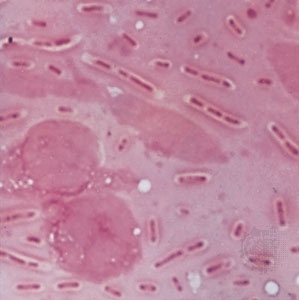Station 1
|
|
Naming Bacteria:Bacteria are the smallest life forms on the planet. they are the first organisms to have inhabited the planet. All bacteria are singled celled and lack a nucleus.
Bacteria are named based upon their shape and how they are arranged. Bacteria have three basic shapes: round, rod, spiral. They arranged themselves in pairs, clumps, or chains. How they arranged themselves is the prefix(beginning of the word), and their shape is the suffix(ending).
EX: a bacteria that is round and in clumps would be called Staphlococcus, many clumps would be staphlococci.
|
Procedure:
- Observe the models on each page, draw them in your journal to the best of your ability.
- Use the chart found on each page to name the bacteria.
- Ensure each drawing is labeled.
|
|
Model A
Model D
|
Model B
Model D
|
Model C
Model F
|
Station 2
|
|
Cell Wall of Bacteria: The structure of the cell wall is another way to classify bacteria. One type has a thick less complex cell wall, while the other is thinner and more complex.
With a technique called gram staining we can identify the two types. The bacteria after the stain will either be violet or purple and pink. If the bacteria stains violet or purple the bacteria is gram positive. If the bacteria stain pink the bacteria is gram negative. Gram negative bacteria have a complex and thinner cell wall.
|
Procedure:
- Use the pictures given of various bacteria. Draw a sketch in your journal.
- Record the name of the bacteria.
- Identify as gram negative or gram positive.
Escherichia coli
Klebsiella pnemoniae

|
|
Station 3
Controlling Bacteria with Antibiotics: Some types of bacteria cause disease and can be controlled by antibiotics (anti means life, biotic means living). Antibiotics are drugs that kill or slow down the growth of bacteria. Some antibiotics are very specific in the types of bacteria they control however. Some bacteria are also very resistant to antibiotics. Scientists can grow bacteria in a petri dish to determine the type of antibiotic that will be most effective in controlling the growth of bacteria.
|
Procedure:
- Observe the two petri dishes above.
- In your journal, write a paragraph that describes the experimental design and compare the effectiveness of the different antibiotics on controlling this strain of bacteria. Use evidence to support your answer.
Station 4
These are spiral bacteria in filaments.
Station 5
This is a rod shaped bacteria have many flagella
|
Streptococcus pnemoniae
Botulism anthracis - Anthrax
|
|